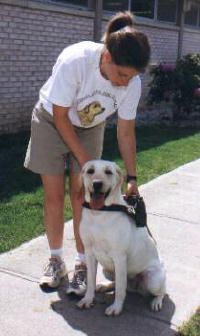Quck answer
Guide dogs are specially trained dogs that assist people with vision impairments. They are trained to navigate their owners through obstacles and help them safely cross streets and intersections. Guide dogs are taught to stop at curbs, stairs, and other potential hazards. They are also trained to follow commands and signals from their owners, such as “forward,” “left,” and “right.” Guide dogs are carefully matched with their owners based on their personality, energy level, and lifestyle. These dogs undergo extensive training to ensure that they are reliable and well-behaved. Guide dogs provide their owners with greater independence and freedom, allowing them to navigate the world with greater ease.
Animal Facts
During and After Work Hours

A harness for a dog is put on by an instructor from Guiding Eyes for the Blind.
Photo courtesy Guiding Eyes for the Blind[
Guide dogs find their work immensely fulfilling, and they derive a lot of satisfaction from doing a good job. However, they are not able to indulge in typical dog fun during the day when they are working. Activities such as games, treats and praise can distract them from helping their handler navigate the course. Even when the handler is not in need of assistance, a guide dog on the job is trained to ignore distractions and remain still. This is because a guide dog must be able to go with its handler to their workplace or be in public areas without causing a commotion.
It is extremely crucial to recognize that a guide dog is on the job when you see one. Petting or talking to the dog can interrupt its concentration, which can impair the handler’s ability to navigate their surroundings. Since guide dogs are highly respected, people have a natural inclination to praise them. However, the best way to assist a guide dog is to leave it alone so that it can concentrate on its surroundings and maintain its focus on its handler. Guiding is a very complex task that necessitates a dog’s undivided attention.
Once a guide dog returns home at the end of the day, it can play and receive praise like any other pet. Guide dogs differentiate between work and play based on their lead harness: when the harness is on, they must remain completely focused, and when it is off, it is time to play. Guide dogs work very hard every day, but they lead extremely happy lives, full of lots of attention and stimulation. Dogs only become guide dogs if they truly enjoy the work. In fact, many handlers report that their dogs eagerly jump into the harness each morning!
FAQ
1. What are guide dogs?
Guide dogs, also known as service dogs, are specially trained dogs that assist people with visual impairments or blindness. They help their handlers navigate the world by guiding them around obstacles and alerting them to potential hazards.
2. How are guide dogs trained?
Guide dogs undergo extensive training from puppyhood to become skilled service animals. They are trained to avoid obstacles and navigate through busy environments, such as streets, stores, and public transport. They also learn to obey commands and respond to their handler’s needs.
3. What breeds of dogs make good guide dogs?
Common breeds used as guide dogs include Labrador Retrievers, Golden Retrievers, and German Shepherds. These breeds are known for their intelligence, loyalty, and calm demeanor, which make them well-suited for service work.
4. How are guide dogs matched with their handlers?
Guide dog organizations carefully match each dog with a handler based on their personality, lifestyle, and needs. The dog’s size, energy level, and temperament are also considered to ensure a good match. Once a match is made, the handler and dog undergo training together to form a strong bond.
5. What tasks can guide dogs perform?
Guide dogs can perform a variety of tasks to assist their handlers, including navigating around obstacles, finding doors and stairs, and alerting them to potential hazards. They can also help their handlers find specific objects, such as a chair or a bus stop.
6. Can guide dogs go anywhere with their handlers?
Under the Americans with Disabilities Act, guide dogs are allowed to accompany their handlers anywhere the public is allowed, including restaurants, stores, and public transportation. They are also allowed in housing that normally prohibits pets.
7. How long do guide dogs work?
Guide dogs typically work for six to eight years before retiring. After retiring, they often stay with their handlers as pets or go to live with a new family.
8. How are guide dogs cared for outside of work hours?
Guide dogs live with their handlers and receive daily care, including feeding, grooming, and exercise. They also receive regular veterinary check-ups to ensure their health and well-being.
9. Are guide dogs expensive to train and maintain?
Training a guide dog can cost up to $50,000, but many guide dog organizations provide their services free of charge. Handlers are responsible for the dog’s daily care and expenses, such as food and veterinary bills.
10. What happens if a guide dog is injured or becomes ill?
If a guide dog is injured or becomes ill, their handler is responsible for seeking veterinary care and providing any necessary treatment. If the dog is unable to work due to their condition, the handler may need to use alternative methods of navigation until the dog recovers.
11. How can I support guide dog organizations?
You can support guide dog organizations by donating money or volunteering your time. Many organizations rely on volunteers to help with tasks such as puppy raising, fundraising, and administrative work. You can also raise awareness about the importance of guide dogs and the services they provide.





Leave a Reply